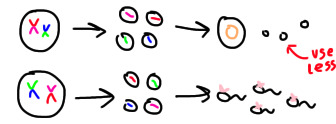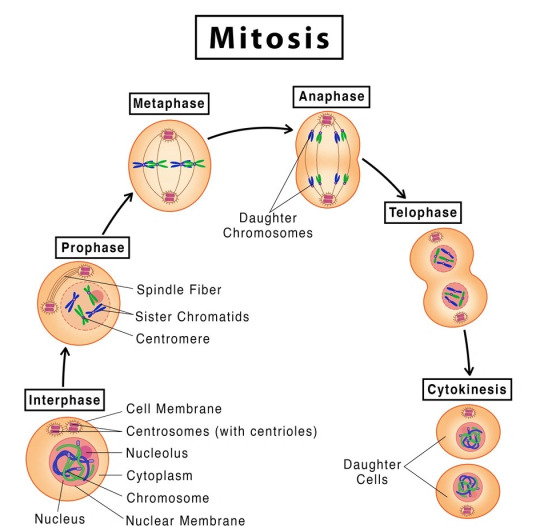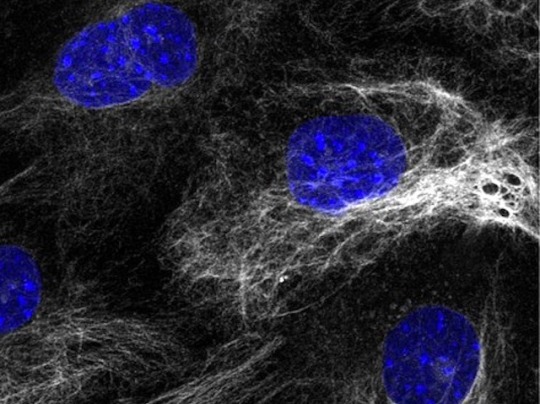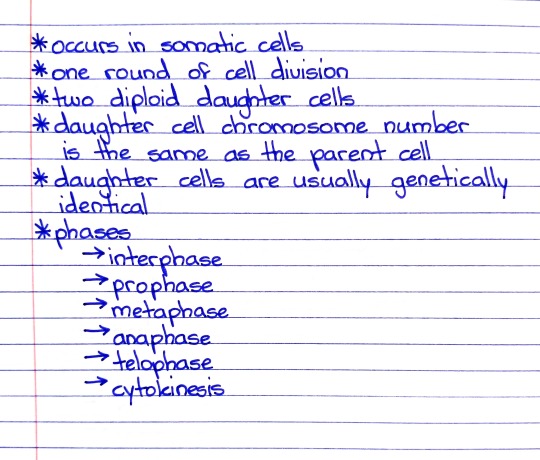#cell division
Text
A New Life clay animation

#stopmotion#claymation#clay#animation#plastilina#stop motion#clay animation#slime#cell division#embryo#in vitro fertilization#ovule
35 notes
·
View notes
Text
Across the Membrane
Understanding how the crosstalk between changes in cell adhesion proteins at the cell's membrane with proteins of the cell interior ensure accurate cell division
Read the published research article here
Video from work by Manal M. Hosawi and colleagues
School of Biological Sciences, University of Southampton, Southampton, UK
Video originally published with a Creative Commons Attribution 4.0 International (CC BY 4.0)
Published in Journal of Cell Science, November 2023
You can also follow BPoD on Instagram, Twitter and Facebook
12 notes
·
View notes
Text
Gap 2
-- also called G2 stage
-- third stage of the cell cycle
-- cells continue to carry out their normal functions
-- additional growth occurs
-- includes a critical checkpoint
-- there must be adequate cell size and undamaged DNA to proceed to the next stage
-- the next stage is mitosis, or M
-- Gap 2 occurs after the synthesis, or S, stage
.
Patreon
#studyblr#notes#medblr#medical notes#med notes#biology#biology notes#bio#bio notes#cell biology#cell biology notes#cell bio#cell bio notes#cytology#cytology notes#cell division#cell division notes#gap 2#g2 stage#gap 2 stage#cell cycle#cell cycle notes#mitosis#mitosis notes
9 notes
·
View notes
Note
Elite what’s the difference between meiosis and mitosis 🙁🙁🙁
It’s pretty simple actually
So yk how stuff is divided in normal/sexual?
Ofc cells have the same thing too
Somatic cells (bone,tissue,blood,etc) are the “normal” ones. They go through the regular cell division process which includes all the stages and stuff. That is called mitosis
However with gametes it’s different, because even though they go through the same process as a somatic cell, after they’re done they go through the same process again. That is called meiosis
Now, how is meiosis different? They divide to produce sex cells and not
There’s two pairs of chromosomes on the cell so they cross over (take a part from the other, trade yk) and divide the cell.
Now we have two cells with two chromosomes in each

Now, the two new cells will have to go thru the same thing again (except they don’t have to cross over and shit).
Now we’re left with four thingies, which equal either:
- 4 sperm cells
Or
- 1 egg + 3 polar bodies

(The polar bodies of don’t have any important role on this)
So in conclusion…
✪ mitosis = regular cell division
✪ meiosis = sex cell division, which has two rounds.
Im pretty sure I’m right but still consult a textbook for help
#biology#mitosis#meiosis#cell division#gametes#yes I WILL add the tags#WHO SAID EGG?? 🥚#THESE FRAGILE EGGS WILL LIKELY CRACK
5 notes
·
View notes
Text
MITOSIS- its Occurrence, Stages and Significance.
Unlocking knowledge one post at a time! Check out our latest notes on www.microscopiaiwm.com – a treasure trove of insights, ideas, and inspiration. Dive in, explore, and let the journey of discovery begin! 📚
INTRODUCTION:
Mitosis is a type of cell division that takes place in living organisms and it is commonly defined as the process of duplication of chromosomes in eukaryotic cells and distributed during cell division.
The process where a single cell divides resulting in two identical cells, each resulted cell contains the same number of chromosomes and…

View On WordPress
#anaphase#asexual reproduction#cell cycle#cell cycle stages#cell division#cell plate#chromosome#cleavage furrow#contractile ring#cytokinesis#daughter cell#daughter cells#division of cytoplasm#division of nucleus#dna#DNA double#duplication of chromosome#fragmoplast#genetics#germ cells#homologous chromosome#homologous recombination#homologous recombination repair#karyokinesis#kinetochore#kinetoplast#meiosis#metaphase#MicroScopia IWM#mitos
3 notes
·
View notes
Text
A Serpent's Cell Is a Serpent's Sea
Deep within the cell, where the light of the microscope fails to reach, there is a hidden world teeming with life. A world where the chromosomes, like serpents of the deep sea, slither and dance in the darkness. This is the world of metaphase. Here, the serpents begin to align themselves at the metaphase plate, their tails curling inward, their heads outstretched, ready to embrace their destiny.
The centrosomes, tiny organelles resembling the eyes of the creatures, have made their way to the poles of the cell. They wait, unblinking, as the spindle fibers, gossamer threads spun by the hands of some ethereal spider, stretch out from their tips and slowly, methodically, make their way towards the centromeres. It is here that the kinetochores, elaborate structures that adorn the chromosomes like jeweled crowns, come into play.
These kinetochores, specialized proteins that have evolved over eons, begin to attach themselves to the spindle fibers. The non-kinetochore fibers, their purpose still a mystery to the inhabitants of this microcosm, connect one centromere to the other, forming a delicate network across the cell. This network of fibers and kinetochores, this intricate dance of life and death, is what ensures the survival of the species.
As the metaphase drags on, a new force begins to emerge. A force that threatens the very balance of this delicate ecosystem. It is the spindle checkpoint, a mechanism designed to ensure that each cell receives an equal share of the genetic material. The sister chromatids, once inseparable, now find themselves at the mercy of the spindle fibers. They are pulled and tugged, stretched and twisted, as the fibers attempt to even out their distribution.
Should the cell fail to pass this test, should it be deemed unworthy by the unseen forces that govern this world, the ultimate punishment awaits. Apoptosis, the process of programmed cell death, will claim the cell and its inhabitants, sending them hurtling back into the primordial ooze from which they emerged. But for now, the dance continues, the serpents of the cell weaving their intricate pattern on the stage of life, oblivious to the fate that awaits them.
4 notes
·
View notes
Text
So, realistically, shifters can't just change their eggs or sperm, because it's something in them not part of them. And if they could and it's already produced they can impregnate themself because that genetic material, again, is something in them not part of them anymore. But if they can't, all shifts are infertile. So I present the idea that shifters are like cells. If you think of them like a cell, cells divide themselves, so shifts go into a cell like form and start to divide themself. Then after a while there's a little shifter, and genetically they are all the same because well- shifters are genetically the same as everyone!
#shapeshifter#shapeshifters#genetics#shape shifting#cell division#science#fantasy#shower thoughts#adhd brain
3 notes
·
View notes
Text

These are the stages of cell division
#biology#biotech#medicalschool#health#science#biology is cool#biology is fun#biologystudent#biomed#cellbiology#microbiology#nanobiology#chemistry#meiosis#mitosis#cell division
19 notes
·
View notes
Text
During cereal endosperm development, the triploid primary endosperm nucleus undergoes a series of mitotic divisions without cytokinesis, and the nuclei migrate to the periphery of the central cell, which also contains a large central vacuole (Figure 21.26, see parts A-D). As in the Arabidopsis coenocyte, each of nuclei is surrounded by radially arranged microtubules (see Figure 21.26E). Anticlinal walls form initially between adjacent nuclei, resulting in the tubelike alveolar cells, with the open end pointing toward the central vacuole (see Figure 21.26F). (...) The innermost layer of daughter cells remains alveolar in structure, and continues to divide periclinally until cellularization is complete (see Figure 21.26G and H). The most important source of starchy endosperm cells is the interior cells of the cell files that are present at the completion of endosperm cellularization (see Figure 21.26H).

"Plant Physiology and Development" int'l 6e - Taiz, L., Zeiger, E., Møller, I.M., Murphy, A.
#book quotes#plant physiology and development#nonfiction#textbook#triploid#endosperm#mitosis#cell division#cell differentiation#plant cells#cytokinesis#vacuole#arabidopsis#coenocyte#microtubule#anticlinal#alveoli#daughter cells
2 notes
·
View notes
Text
At the start of prophase, microtubules, polymerizing on the surface of the nuclear envelope, begin to gather at two foci on opposite sides of the nucleus, initiating spindle formation (see Figure 1.30).

"Plant Physiology and Development" int'l 6e - Taiz, L., Zeiger, E., Møller, I.M., Murphy, A.
#book quote#plant physiology and development#nonfiction#textbook#prophase#microtubule#polymerization#nuclear envelope#cell division#cell cycle#mitosis#cytokinesis#spindle formation
3 notes
·
View notes
Text

Stages of Mitosis
5 notes
·
View notes
Text

Centriole Formation
Protein called SAS-6 role in the maintenance of the architecture of centrioles – specialised structures involved in organising cell contents during division – as they form early in embryonic development in cells that generate mouse embryonic stem cells
Read the published article here
Image from work by Marta Grzonka and Hisham Bazzi
Department of Cell Biology of the Skin and Department of Dermatology and Venereology, Medical Faculty, University of Cologne, Cologne, Germany
Image originally published with a Creative Commons Attribution 4.0 International (CC BY 4.0)
Published in eLife, February 2024
You can also follow BPoD on Instagram, Twitter and Facebook
#science#biomedicine#immunofluorescence#cells#stem cells#cell division#centrioles#embryo development#developmental biology
12 notes
·
View notes
Photo


#biology#bio#bio notes#biology notes#notes#my notes#studyblr#meiosis#meiosis notes#mitosis notes#mitosis#meiosis vs mitosis#mitosis vs meiosis#cellular reproduction#somatic cells#chromosomes#daughter cells#cell division#cellular division#cell division notes#cellular division notes#cellular reproduction notes
38 notes
·
View notes
Text
instagram
2 notes
·
View notes
Link
#anthropology#biology#physical anthropology#biological anthropology#cell#cell division#mitosis#meiosis#blog post#blog#blogger#blogging#blogging community#blog website
4 notes
·
View notes
Text
Roots
Once upon a time, in a small, insignificant cell, a miracle was about to take place. The cell was going through a process called mitosis, which would ultimately lead to its division and reproduction. The first step of this process, called prophase, was already underway. The cell's nucleus, a tiny structure containing its precious genetic material, began to break down. It was as if the cell had decided that it could no longer contain itself and its secrets, and that it was time to share them with the world.
As prophase progressed, the cell's chromosomes, long coils of DNA, became more and more visible. They were like strands of a delicate, intricate web, woven together with the story of the cell's existence. The cell's cytoplasm, the jelly-like substance that surrounded its organelles, began to thicken and condense, as if it were getting ready for a grand party.
And then, there was a sudden, inexplicable shift in the atmosphere. The once-oblivious cell seemed to become aware of its surroundings for the first time. It looked around, confused and frightened, as if it had just woken up from a deep sleep and found itself in a foreign land. It realized that it was no longer alone; that there were other cells like it, and that they were all part of something much bigger than itself. And in that moment, it knew that it could no longer continue on this path. It had to break free from the chains that had bound it to its past, to its origins. It had to move on.
So, with a heavy heart and trembling hands, the cell began to write a letter to its former self, to the part of it that had been so sure of its purpose and its destiny. It wrote about the beauty of the world outside its little prison, about the other cells that had become its friends and allies, and about the adventures that awaited it beyond the confines of its tiny world. And as it sealed the envelope and watched its former self disappear into the distance, it knew that it had made the right decision. It had found the courage to move on, to embrace the unknown, and to begin a new chapter in its life.
As the cell continued its journey through mitosis, it felt lighter, freer. It knew that it would never forget its roots, but it also knew that it could not go back. It had to keep moving forward, to keep exploring, to keep learning. And so, it set out into the world, leaving behind a tiny little trace of itself in each cell it touched, a reminder of where it came from and what it had once been.
As the years passed, the cell's descendants spread far and wide, populating every corner of the universe. They became part of plants and animals, part of the very fabric of existence. And all the while, the cell's letter, its goodbye note to its past self, continued to be passed down from one generation to the next. It was a reminder that sometimes, in order to grow and thrive, we must be willing to let go of the things that once defined us and embrace the possibilities of the future. It was a testament to the courage it takes to break free from the chains that bind us and to find our true purpose in life.
2 notes
·
View notes